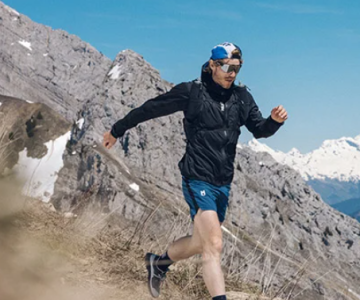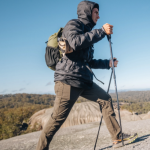Trekking poles are a valuable tool for hikers, runners, and backpackers alike. They provide added stability, enhance balance on rough terrain, and can make uphill climbs easier. If you’re considering adding a pair to your gear, you may find it tricky to know where to start. Whether you’re new to trekking or looking to upgrade your current set, this guide will help you choose the best trekking poles for your next adventure.
Understanding the Types of Trekking Poles
Trekking poles come in various styles, each suited to specific needs. Let’s explore the main types and their benefits:
Single-Piece Poles
Single-piece trekking poles are fixed-length and offer the lightest and most durable option. They are ideal for those who plan to use their poles consistently during their adventures. However, because they are not adjustable, they are best suited for experienced trekkers who know their ideal pole length and are comfortable carrying them when not in use. These poles have no joints, making them reliable and sturdy, especially on long trips.
Foldable Poles
Foldable trekking poles are a newer option, favored for their compact size. These poles are incredibly lightweight and easy to pack down, which makes them perfect for runners or alpine climbers who need to stow them away when not in use. While they are not as durable as telescoping poles, they still provide adequate support for light trekking. However, they are fixed in length, which can make certain tasks, like tarp rigging, a bit more challenging if the pole length is unsuitable.
Adjustable-Length Poles
Adjustable trekking poles are the most versatile and commonly used. These poles allow you to adjust their length, which makes them ideal for diverse terrain, from uphill climbs to flat stretches. There are two primary designs: three-section telescoping poles, known for their durability and strength, and hybrid poles that combine the folding and telescoping features. The hybrid poles provide a slightly less adjustable option but with minimal added weight. If you’re looking for flexibility and a mix of sturdiness and portability, adjustable-length poles are a solid choice.
Key Features to Consider
Once you’ve narrowed down the type of pole, it’s important to understand the specific features that make a trekking pole work for your needs.
Grip Material
The grip material plays a significant role in comfort during use. There are three main types of grips: cork, foam, and rubber.
- Cork: Cork grips are known for their comfort. They mold to your hand over time and remain cool in warmer conditions. However, cork doesn’t absorb sweat as well as foam, which can make it slippery during long hikes.
- Foam: Foam grips are light, absorb sweat, and offer a high level of comfort, making them ideal for warm weather activities. However, like rubber, they can sometimes cause blisters or hotspots if friction is a concern.
- Rubber: Rubber grips are heavier and don’t absorb moisture, but they provide excellent insulation. They are well-suited for colder environments like mountaineering and snowshoeing.
Straps
Trekking poles should always have straps, as they help secure the poles in your hands, even when you loosen your grip. Straps also prevent the poles from falling if you accidentally drop them. Some poles feature left- and right-hand specific straps for added comfort, and padded straps can help prevent chafing during long treks.
Locking Mechanisms
The mechanism that holds your trekking poles in place is crucial. While folding poles typically use an internal elastic cord, adjustable-length poles may feature twist-locks or lever-lock systems. Lever locks are the preferred option for most hikers because they are more secure and easier to adjust.
Shaft Material
The material of the pole’s shaft affects its weight and durability. Two common materials are:
- Aluminum: Aluminum poles are sturdy and affordable, making them a great choice for rugged terrain and heavier use. They are slightly heavier than carbon poles but are built to withstand more abuse.
- Carbon: Carbon poles are incredibly lightweight and provide better energy efficiency over long distances. They are often favored by trail runners and fastpackers, but they are more prone to damage if subjected to rough use.
Size and Packability
When selecting trekking poles, consider how compact they are when folded. If you plan to attach your poles to a vest or backpack, foldable or hybrid poles are excellent choices as they pack down small and can be quickly assembled.
Baskets
Different types of baskets are designed for different conditions. Larger baskets are ideal for snow and softer ground, as they prevent the poles from sinking too deep. On rocky, dry trails, smaller baskets—or no baskets at all—are preferable, as larger baskets can get caught on roots or bushes.
Trekking Pole Tips
Trekking poles can be a great asset on your journey, but there are a few additional tips to ensure their longevity and effectiveness:
- Tip Protection: Metal tips can damage trails, so use rubber tip protectors on rocky terrain or busy trails to avoid scarring and unnecessary noise. Rubber protectors help poles grip slick rocks, but be sure to carry spares in case they fall off.
- Shock Absorbers: While some poles come with built-in shock absorbers, these are not always necessary. In fact, shock-absorbing poles can add weight and reduce your energy efficiency. For most hikers and runners, poles without shock absorbers offer better control and comfort.
Sizing Your Poles
Correct sizing is crucial for optimal performance, especially if you’re using fixed-length or foldable poles. When choosing a trekking pole, your arms should form a 90-degree angle when holding the poles with the tips touching the ground. Refer to the chart below for general size recommendations based on height, but always consult the manufacturer’s guidelines for precise measurements.
- Height under 154 cm: 100 cm (39 in)
- Height 154 – 171 cm: 110 cm (43 in)
- Height 172 – 182 cm: 120 cm (47 in)
- Height over 183 cm: 130 cm (51 in)
Best Poles for Different Activities
For Trail Runners
Trail runners typically benefit from foldable carbon poles. These poles are lightweight, durable, and easy to pack down, making them perfect for running long distances on rugged terrain. If you need a bit more flexibility, consider hybrid poles, which offer adjustable length without adding too much weight.
For Backpackers
Backpackers generally opt for three-section telescoping poles. These poles are sturdy and reliable, making them ideal for carrying heavy loads over extended periods. Although carbon poles are popular among thru-hikers for their light weight, consider the added durability of aluminum poles if you’re facing tough, rocky terrain.
Conclusion
Choosing the right trekking poles depends on the activity, terrain, and your personal preferences. Whether you’re trekking through the mountains, running across trails, or embarking on a backpacking trip, the right set of poles can make your journey more efficient and enjoyable. By considering factors like material, sizing, and intended use, you’ll be equipped to select the perfect pair for your next adventure.





